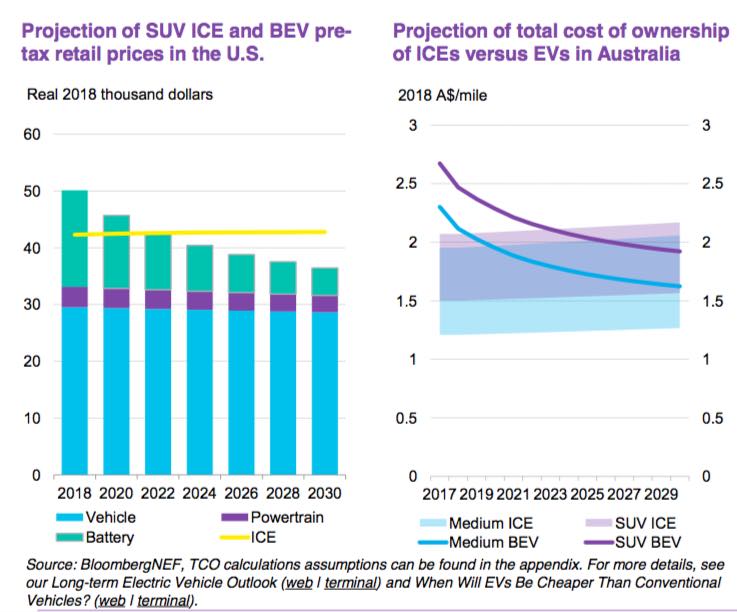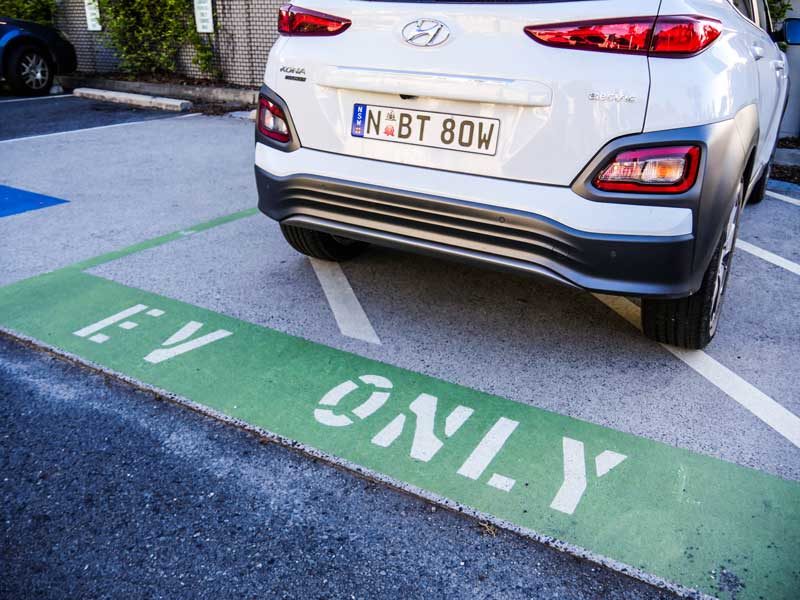The total cost of ownership of some electric vehicles in Australia could match that of their petrol and diesel equivalents as soon as next year, according to BloombergNEF, and – with the right policies – the share of new vehicle sales could reach 50 per cent by 2030 as targeted by Labor.
In a major new report looking at the Australian vehicle market, BNEF says the prospect of growing interest in EVs and their rapidly falling costs means that the share of new sales would likely reach 28 per cent on a “business-as-usual” basis.
But, it says, with the right policies the gap between 28 per cent and Labor’s targeted 50 per cent could be reached. And it appears to endorse Labor’s strategy of focusing on the fleet market, which BNEF says will be the first large-scale adopters of EVs.
Fleet owners are more attuned to the “total cost of ownership” rather than just the upfront costs, and a breakthrough moment could occur as early as next year, BNEF suggests in its report.
“Electric vehicles should start to achieve total cost of ownership parity with equivalent ICEs (internal combustion engine) as early as 2020 in Australia for some segments of the market,” BNEF analyst Ali Asghar says in his report.
“The TCO (total cost of ownership) is the metric likely to influence purchasing decisions of fleet owners and managers,” he says.
“Since TCO parity could start earlier than upfront cost parity of EVs (relative to ICEs), it is likely that fleet purchases in Australia will pick up prior to significant growth in private car purchase.”
Labor’s proposal to target a 50 per cent per share of new vehicle sales for electrics and plug in hybrids by 2030 has – surprisingly – caused uproar in Australia as the Coalition and conservatives reacted with bizarre predictions of the death of the weekend and accusations that Labor wanted to “steal” people’s utes.
The debate is even more bizarre because the Coalition’s own emissions reduction policy assumes as uptake of EVs somewhere between the BNEF forecasts and Labor’s target. It plans to reveal its own EV strategy next year, should it retain government, but refused to do so in the election campaign.

This graph illustrates BNEF’s forecast for total cost of ownership in Australia. It shows that it may be another few years before the popular SUV vehicle class reaches parity, but medium sized battery electric vehicles could reach TCO parity in 2020.
The graph to the left comes from the report released by BNEF earlier this month on the global market, which suggested that the upfront cost of electric vehicles could beat their ICE equivalents by 2023. Australia could follow within a year or two.
But this is highly dependent on manufacturer choices, and – for local consumers – how they react to the Australia market, and whether there are fuel emissions standards in place (Currently, there are none, but Labor is proposing to follow US, rather than the stricter European, standards).
By 2030, BNEF predicts, the average cost of a midsize battery electric vehicle will decline from more than $50,000 in 2018 to near $37,000 by 2030. That puts it in the middle of the $20,000 to $50,000 range that Australians now spend on such cars.
The average cost of a SUV battery vehicle is expected to fall from around $60,000 in 2018 to around $45,000 by 2030. This is in the mid to higher range of the $30,000 to $50,000 range that Australians now spend on such vehicles.
(It is interesting to note Tesla’s experience that buyers of its top selling Model 3 have “upgraded” their normal spending range while buying the highly sought-after EV. But it’s not clear this will be true of the real “mass-market”.
(Also, BNEF notes these predictions are “averages”, so some EVs could be cheaper, earlier, than their ICE equivalents. Sanjeev Gupta, for instance, is still insisting he will set up an EV manufacturing plant in Australia with low-cost EVs that he says will fall in price like TV screens).
Still, BNEF notes, the difference between business as usual and what could happen with policy intiatives is significant, as this graph below illustrates.

“Labor’s 50 per cent EV target by 2030 will require significant policy support measures to be achieved,” Asghar notes. But he says the package of incentives, including tax deductions focused on the business fleet and new emissions standards, along with charging infrastructure, could work.
“Labor’s … announced policy measures such as the fast charging infrastructure fund, incentives for new real estate developments to build EV charging capability, vehicle emissions standards and business fleet tax deductions could help plug the gap,” Asghar says.

Giles Parkinson is founder and editor of The Driven, and also edits and founded the Renew Economy and One Step Off The Grid web sites. He has been a journalist for nearly 40 years, is a former business and deputy editor of the Australian Financial Review, and owns a Tesla Model 3.

